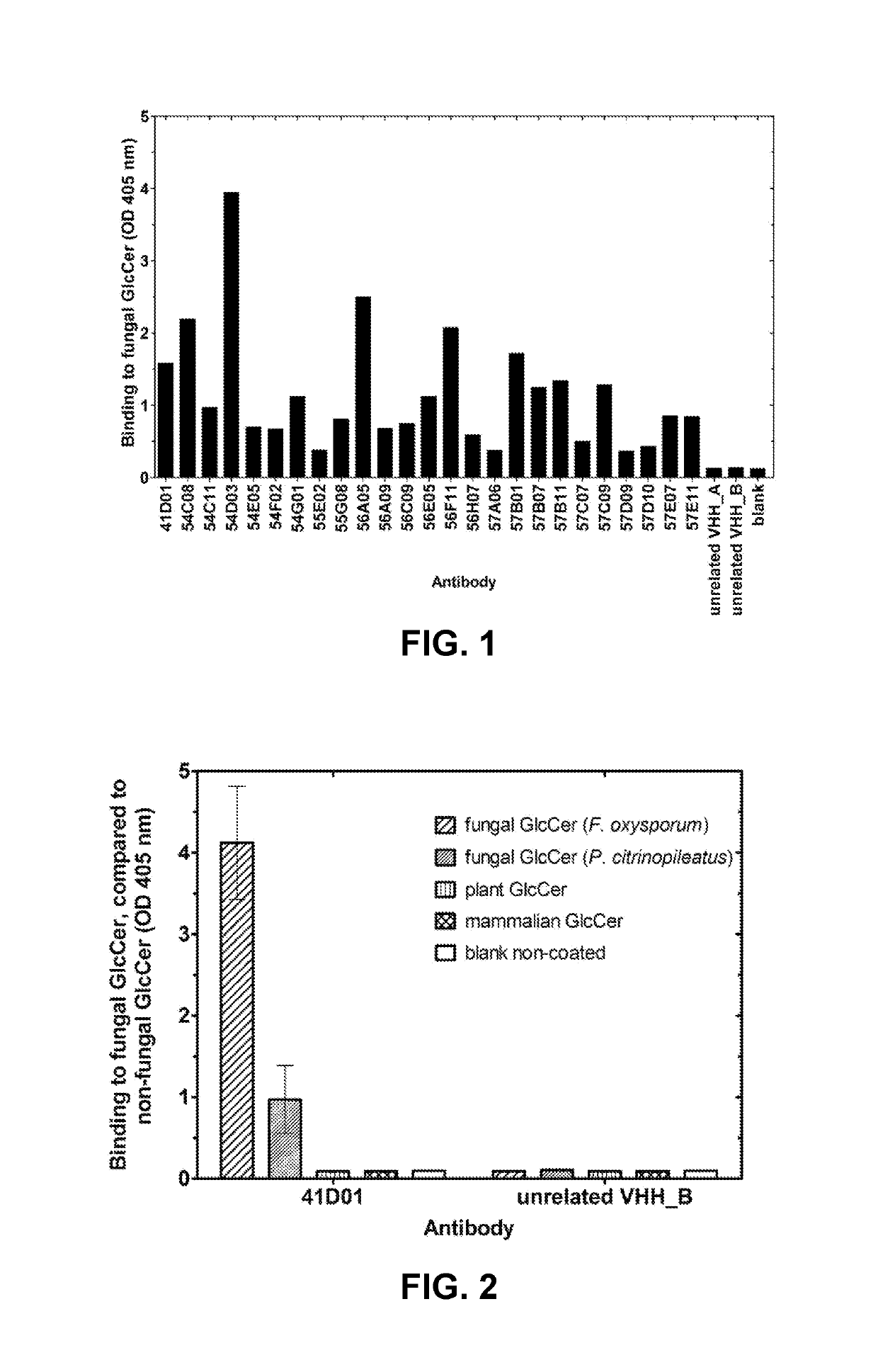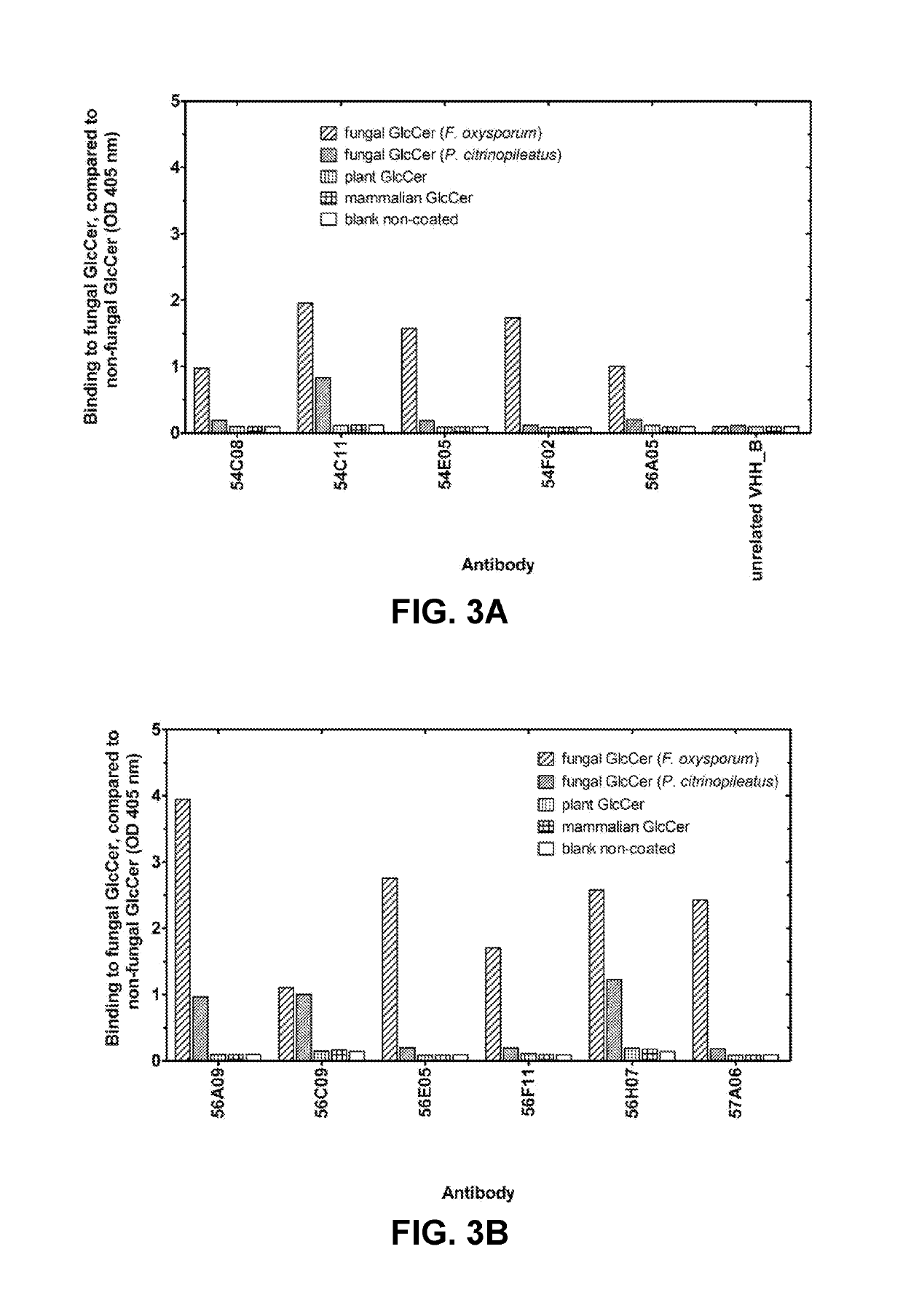Agrochemical compositions comprising antibodies binding to sphingolipids
a technology of sphingolipids and agrochemical compositions, which is applied in the field of agrochemical compositions comprising antibodies binding to sphingolipids, can solve the problems of few proteinaceous or peptidergic pesticides known, high toxicity of amphotericin b, and toxicity threats to both agricultural workers during handling and the environment, so as to reduce unwanted side effects, reduce treatment dosage, and reduce the effect of treatmen
- Summary
- Abstract
- Description
- Claims
- Application Information
AI Technical Summary
Benefits of technology
Problems solved by technology
Method used
Image
Examples
example 1
of Nucleic Acid Sequences Encoding Peptides with Affinity for Fungal Glucosylceramide
[0705]Animal Immunizations:
[0706]VHHs were generated from llamas immunized with fungal glucosylceramide (GlcCer). Llamas were immunized according to standard protocols with six boosts of thin Layer Chromatography (TLC)-purified (99%) glucosylceramide (GlcCer) from Pleurotus citrinopileatus (Nacalai Tesque). Purified GlcCer was dissolved in a water:methanol:chloroform mixture and spotted on a TLC silica glass plate. Silica with adsorbed GlcCer was scraped from the plate and suspended in phosphate buffer. The suspension was sonicated, mixed with Freund incomplete adjuvant, and used for subcutaneous injections. VHH were also generated from llamas immunized with native germinated fungal or oomycete spores. Llamas were immunized according to standard protocols with six boosts of native germinated spores of Botrytis cinerea or Phytophthora infestans by subcutaneous injections. All llamas remained healthy ...
example 2
Evaluation of the Antifungal Activity of Anti-GlcCer VHH Compositions
[0729]In Vitro Evaluation of the Antifungal Activity of VHH:
[0730]The antifungal activity of the anti-GlcCer-VHH was tested using antifungal assays in liquid media and on agar plates as described in Thevissen et al., 2011, Bioorg. Med. Chem. Lett. 21(12):3686-92; Francois et al., 2009, J. Biol. Chem. 284(47):32680-5; Aerts et al., 2009, FEBS Lett. 583(15):25143-6. The minimal inhibitory concentration (MIC) was determined for the VHH on in vitro growth of Botrytis cinerea and Phytophthora infestans.
[0731]An in vitro assay to test fungal growth in liquid media in 96-well plate format can also be used to directly screen different VHH that are generated against integral fungal material and selected against molecular antigens, different from GlcCer, for antifungal activity. This screening is performed on crude VHH-containing periplasmic extracts of E. coli cells in which the VHH are produced, or with purified VHH.
[0732...
example 3
on of VHH into Agricultural Formulations
[0742]Anti-GlcCer VHH were produced as recombinant proteins in a suitable E. coli production strain. Anti-GlcCer VHH were purified from the media and / or the periplasm and / or the E. coli cells were killed and lysed at the end of the fermentation process. Anti-GlcCer VHH can also be produced as recombinant proteins in Pichia pastoris, or Saccharomyces cerevisiae and secreted into the fermentation media. Anti-GlcCer VHH are then purified from media components and cell constituents by diafiltration.
[0743]The resulting protein solution is diluted in a suitable buffer, such as phosphate buffered saline, to adjust the pH to about 7. Optionally a biocidal agent, such as sodium azide in a concentration of about 0.0001% to 0.1% and a non-ionic detergent, such as TWEEN®-20 in a concentration of about 0.0001% to 5%, is added to the buffered protein solution.
[0744]Alternatively, the resulting protein solution is admixed with a suitable wetting and dispersi...
PUM
| Property | Measurement | Unit |
|---|---|---|
| dissociation constant | aaaaa | aaaaa |
| dissociation constant | aaaaa | aaaaa |
| dissociation constant | aaaaa | aaaaa |
Abstract
Description
Claims
Application Information
 Login to View More
Login to View More - R&D
- Intellectual Property
- Life Sciences
- Materials
- Tech Scout
- Unparalleled Data Quality
- Higher Quality Content
- 60% Fewer Hallucinations
Browse by: Latest US Patents, China's latest patents, Technical Efficacy Thesaurus, Application Domain, Technology Topic, Popular Technical Reports.
© 2025 PatSnap. All rights reserved.Legal|Privacy policy|Modern Slavery Act Transparency Statement|Sitemap|About US| Contact US: help@patsnap.com



